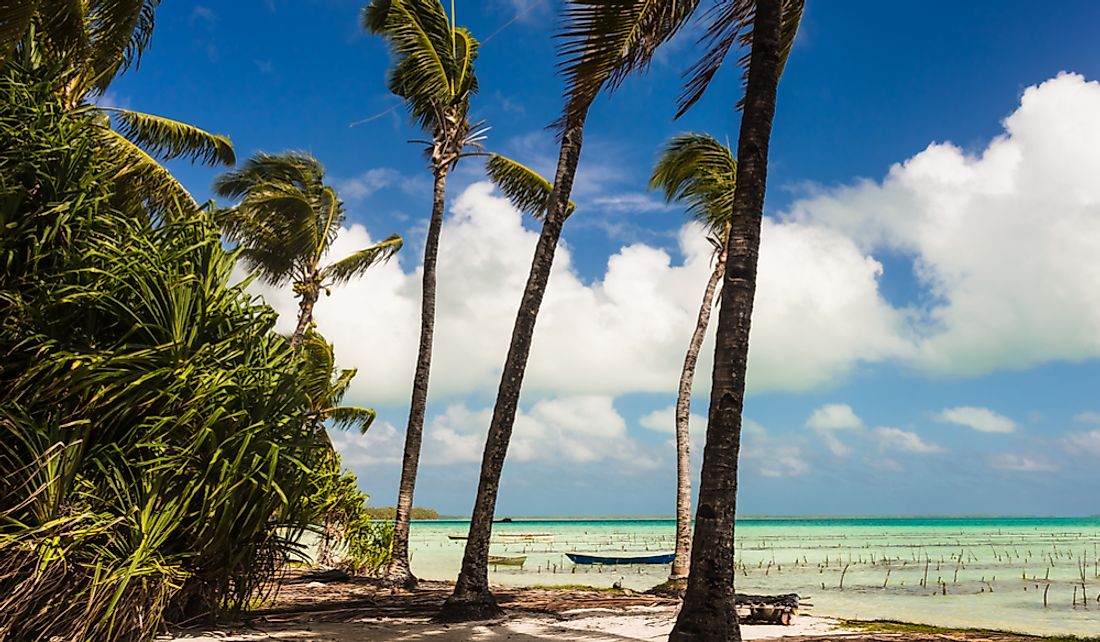What Are The Major Natural Resources Of Kiribati?

The Micronesian nation of Kiribati is considered one of the poorest countries in the region. In 2017, the Kiribati gross domestic product was $196.2 million while its per capita gross domestic product was $1,685. Kiribati has limited natural resources of great economic significance such as arable land, fish and phosphates. Despite the limited natural resources in Kiribati, the government has put in place several measures to grow the country's economy.
Natural Resources of Kiribati
Fish
Kiribati has significant fish resources that are the most important natural resources. In 2000, the fishing sector contributed $11,729,000 to the Kiribati gross domestic product. Like in most island nations, fishing in Kiribati is divided into three main segments, subsistence fishing, commercial fishing, and sports fishing. Most of the subsistence fishermen in Kiribati use traditional canoes that have been slightly modified by the addition of outboard motors. The fishermen also use traditional fishing methods such as trapping, spearing, and netting. According to the Kiribati government, commercial fishing was mainly centered on Tarawa. In 2000, roughly 200 commercial vessels were fishing within Kiribati's waters. The most common type of fish caught by Kiribati fishermen was the tuna. Other nations such as the United States, Spain, and Japan were granted the rights to fish within Kiribati's waters. The government of Kiribati has partnered with other governments such as the Japanese government to improve the country's fishing sector. Sports fishers are mainly attracted to Kiribati because it is home to several fish species such as the bonefish and the marlin. Sports fishers usually prefer to visit the island of Kiritimati, which is the largest coral atoll in the world. Several hotels have been set up to cater to the significant number of leisure fishers who visit the country.
Arable Land
One of Kiribati's most critical natural resources is arable land which made up roughly 2.47% of the country's total land area in 2014. The data indicated that the size of arable land in the country had remained relatively unchanged from 2004 to 2014. The agricultural sector is one of Kiribati's most essential industries as it contributed 24.3% of the country's gross domestic product in 2010. The Kiribati labor department estimated that in 2000 approximately 2.7% of Kiribati's labor force was employed in the agricultural sector. Farmers in Kiribati grow a wide array of crops such as sweet potatoes, coconuts, and vegetables. Most of the plants grown in Kiribati are used to feed the local population while some are exported to other nations. Despite the significant farming carried out in the country, the residents are forced to import most of the food they consume. Kiribati's agricultural sector faces considerable challenges such as infertile soils, insufficient water to irrigate the land, and the land tenure system. The problems have significantly affected Kiribati's food security, and the government has attempted to put in place several policies to ensure that the country achieves food security.
Coconuts
In Kiribati, the most important crop is coconut as some experts believed that it could be found in about than 80% of the country. One of the most critical uses of coconuts to the Kiribati people is in the making of toddy, which is one of the most popular drinks in the country because it is a source of vital vitamins. In rural areas of Kiribati, they consume the flesh of the coconut, which is a source of dietary fat. The Kiribati people also use the other parts of the coconut tree for various purposes with the roots being the most important as they are used to make dyes and toothbrushes.
Forests
Data from the UN indicates that roughly 15% of Kiribati's area was covered in forests in 2010. Kiribati's forests are home to approximately 50 species of animals of which 16% are endemic while 12% are considered threatened. One of the most important species of forests in Kiribati is the mangrove forest. In 2011, the government of Kiribati participated in a project to plant roughly 37,000 mangrove trees in several parts of the country's islands such as the Aranuka Island, Makin Island, and Tarawa Island. The mangroves are vital to Kiribati as they are considered the least expensive form of coastal protection. The mangroves are also important because they do not require constant maintenance and they provide firewood to the residents.
Beautiful Scenery
Kiribati has been blessed with a variety of beautiful sites that attract a huge number of tourists to the country. Some of the premier tourist destinations in Kiribati include Christmas Island, the Outer Islands, and Tarawa. Christmas Island is often referred to as Kiritimati and is often considered one of the best areas in the world to spot unique varieties of bird species. Apart from bird watching, Christmas Island is also famous because it is home to several species of turtles as well as numerous wreckage from the Second World War. Tarawa, the country's capital, is one of the unique islands in the world because it is shaped like a boomerang. Tarawa has several lagoons and is one of the most popular reef fishing destinations in the world. The Outer Islands, which are the least explored islands in Kiribati, are often considered the most beautiful islands in the country. Within the Outer Islands, the most common activities include scuba diving and sports fishing. The government of Kiribati has put in place several measures to grow the country's tourism industry with one of the major ones being advertising in international media outlets. The government of Kiribati allows residents of several nations such as Japan and several others to visit the island without a visa for a limited time which has contributed to increasing the number of tourists who visit the country.
Economy of Kiribati
Kiribati's economy is numerous challenges such as the country's small size and the limited natural resources in the country. The government of Kiribati partnered with several other nations such as Australia and New Zealand to grow its economy.











